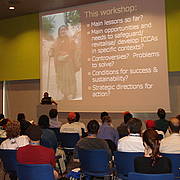Use indigenous and community conserved areas to save nature
06 October 2008 | News story
With exciting new developments in conservation, the concept of Indigenous and Community Conserved Areas came out loud and clear at an alliance workshop at the IUCN World Conservation Congress in Barcelona.
“We need to recognize and support indigenous and community conservation. This will truly help to safeguard the diversity of the environment,” said Grazia Borrini-Feyerabend, Co-Chair of the IUCN Commission on Environmental, Economic and Social Policy (CEESP).
“Conservation needs equity. That means fair sharing of the costs and benefits of preserving biodiversity, and respect for human rights,” added Borrini-Feyerabend, while addressing the packed gathering of protected area professionals.
Indigenous and Community Conserved Areas are natural sites conserved in voluntary ways by indigenous peoples and local communities throughout the world. This conservation practice, which is strongly linked to local livelihoods and the spiritual and material values of local cultures, is the oldest on Earth.
Ashish Kothari, Co-Chair of the Working Group on Indigenous Peoples, Local Communities, Equity and Protected Areas, said that such areas are not necessarily ‘protected areas’ in official terms.
“The working group and partners have been implementing initiatives to increase knowledge about these protected areas, including regional reviews, national surveys of policy and legislation and in-depth case studies,” said Ashish Kothari. “We hope they will help build a better understanding about indigenous and community conserved areas.”
The workshop called on people and institutions to show indigenous and community conserved areas are powerful conservation systems.





